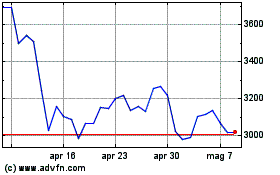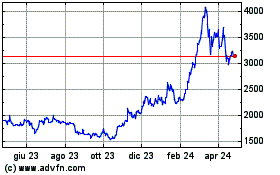Waiting for altcoin season? Data suggests it’s already here
25 Marzo 2025 - 7:27PM
Cointelegraph


Few things in crypto are as elusive and misunderstood as the
concept of an “altcoin season.” Traditionally, this term referred
to a brief window — usually 2–3 months — following a Bitcoin (BTC)
price rally, where altcoins outperform BTC in cumulative returns.
That pattern held in the 2015–2018 and 2019–2022 cycles, but the
verdict is not yet in on whether the current bull market has had
its altcoin season.
The Blockchain Center
defines an altcoin season as a period when 75% of the top 50
altcoins outperform Bitcoin over a rolling 90-day timeframe. Its
Altseason Index registered upticks in March 2024 and again in
January 2025 — but neither lasted long enough to qualify as a
full-fledged altseason.

Altcoin season index. Source: Blockchain Center
Some analysts argue that memecoins drained liquidity from the
broader altcoin market. Others blame the oversaturation of crypto
investment products — particularly ETFs — which cater to
institutions and spotlight only the largest altcoins. A third
explanation calls for a deeper rethink of what altcoins actually
are. Within this view, altcoins are perceived as a unified asset
class but are a diverse collection of crypto assets with different
functions, value structures, and growth potential.
Memecoins stole the spotlight
For the crypto analyst Miles Deutscher, the
launch of
Pump.fun is
directly correlated to the destruction of the altcoin market vs
BTC.
“The reason we’ve seen no major “altseason” across
majors is because the speculative capital that would’ve once poured
into top 200 assets, instead decided to jump the gun and flood into
onchain low caps instead.”
Deutscher notes that the early birds and insiders got insanely
rich from this, but most retail investors who entered late lost.
This was also the case in previous altcoin cycles. However, unlike
2022, where the losses were mainly limited to CEX altcoins with
solid liquidity, they got stuck into illiquid onchain memecoins,
which quickly retraced 70%-80%. This led to a “wealth destruction
event greater than the early 2022 bear (LUNA aside),” even though
BTC (and some majors) are still in a macro bull trend.

Solana TVL vs Top 125 Alts (excl. Top 10). Source: Miles
Deutscher
Politics in the United States added fuel to the memecoin craze.
For example, President Donald Trump’s public embrace of memecoins
sparked momentum — but the results quickly disappointed. TRUMP and
MELANIA tokens have dropped 83% and 95%, respectively, since
launching at the end of January, delivering another hit to retail
sentiment.
Related: Will
new US SEC rules bring crypto companies
onshore?
Institutional investors and ETFs shifted the tide
Another factor impacting the strength of the current bull
market’s altcoin season was the arrival of Wall Street. The launch
of spot Bitcoin ETFs in January 2024 brought $129 billion in
inflows as investors rushed into familiar structures with custody,
regulation, and easy access. BlackRock’s IBIT became a dominant
vehicle, and the introduction of ETF options in July 2024 added
even more depth.
Some analysts believe that the safety and scalability of
spot BTC ETFs
sucked capital away from speculative assets. With the ability to
hedge through options and futures, the incentive to gamble on
illiquid, low-volume altcoins diminishes significantly.

But this explanation has limits. Crypto is not a zero-sum market
— global liquidity is growing, and capital entering the space can
flow in many directions. If anything, institutional demand could
expand the total crypto pie.
Furthermore, some altcoins already have their ETFs as well. Spot
Ether ETFs debuted in July 2024 and have since registered a modest
net inflow of $565,000, according to CoinGlass. Such a drastic
difference in scale with spot BTC ETFs suggests that the ETF
structure alone isn’t enough; investor conviction still
matters.
Altcoin’s function and their rallies became more nuanced
The term “altcoin” emerged when any non-Bitcoin token was novel.
But in today’s ecosystem, the term lumps together wildly different
assets: blockchain-native coins, governance tokens, stablecoins,
memecoins, DApp tokens, and real-world asset protocol tokens — each
with distinct functions and investor profiles. Just as it wouldn’t
make sense to group gold, Nvidia stock, and the US dollar into a
single index in traditional finance, it makes little sense to treat
all altcoins as one unified category.
A closer look at price action supports this idea. According to
CoinGecko data, major altcoin categories have
diverged sharply this
cycle. Real-world asset (RWA) tokens surged 15x. GameFi, by
contrast, lost half its market cap. This shows that narratives play
a growing role in driving investors’ capital allocation
decisions.

Crypto categories market cap. Source: CoinGecko
Even core blockchain tokens have started to specialize. Ethereum
remains the hub for DeFi. Solana dominates memecoins. Tron now
holds second place in stablecoin transfers. ImmutableX is carving
out its territory in the gaming space. In each case, token
performance is increasingly tied to ecosystem activity. This means
that we might want to abandon the term “altseason” and start to pay
more attention to specific narratives within the crypto space.
Altcoins aren’t moving as a pack anymore, and that might be the
biggest signal of how the crypto market is maturing.
This article does not
contain investment advice or recommendations. Every investment and
trading move involves risk, and readers should conduct their own
research when making a decision.
...
Continue reading Waiting for altcoin season? Data
suggests it’s already here
The post
Waiting for altcoin season? Data suggests it’s
already here appeared first on
CoinTelegraph.
Grafico Azioni Ethereum (COIN:ETHUSD)
Storico
Da Mar 2025 a Apr 2025

Grafico Azioni Ethereum (COIN:ETHUSD)
Storico
Da Apr 2024 a Apr 2025
